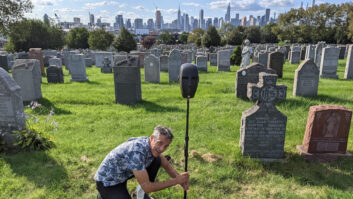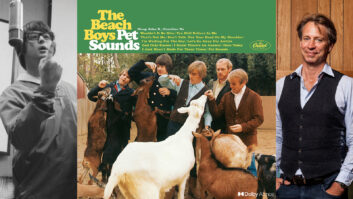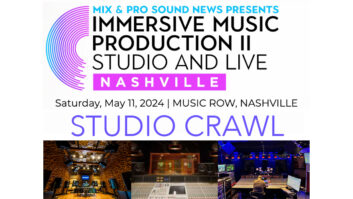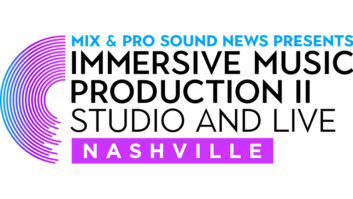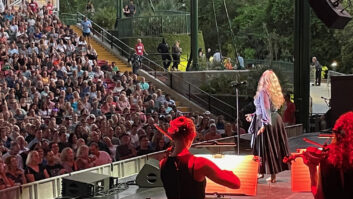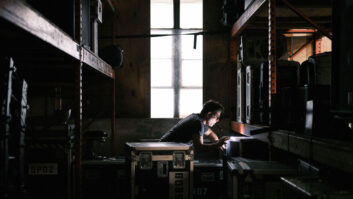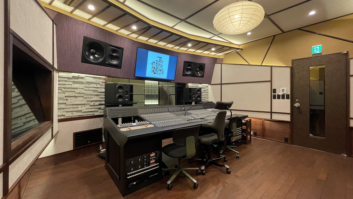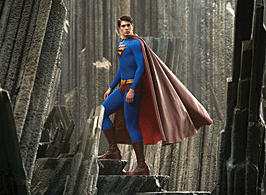
It’s a new day for what was once one of the most lucrative franchises in film: DC Comics’ Superman was the subject of four smash films between 1978 and 1987, starring Christopher Reeve as Krypton’s most famous refugee. Now, nearly 20 years later, we have a new Superman, Lois Lane and arch-villain Lex Luthor; one of the hottest young directors at the helm; and special effects that are light-years beyond what was possible in the earlier films. Superman doesn’t just return — he’s reborn!
Director Bryan Singer, who made the first two X-Men movies (as well as The Usual Suspects and the pilot for the hit TV show House, M.D.), likes to work with many of the same technical crew from film to film — carryovers include editor/score composer John Ottman, cinematographer Newton Thomas Sigel, costumer Louise Mingenbach and sound designer Craig Berkey (who was also supervising sound editor). Berkey brought in sound designer Erik Aadahl; the two have worked together many times during the past few years, and both came into the Superman gig with copious experience working in the sci-fi/superhero genre.
Together or separately, they’ve done sound work on both X-Men movies, Elektra; I, Robot; Daredevil; and Fantastic Four (though the last time they were in the pages of Mix it was for their fine work on the impressionistic Terrence Malick film The New World, which couldn’t be more different from Superman Returns). During a break from the final mix of Superman Returns at Warner Bros. in late May, I spoke to Aadahl and Berkey about the sounds they created for the Man of Steel’s unearthly powers. I started by asking Berkey whether the sound of the original films had any impact on the choices they made sonically.
“No, not at all,” he says. “I went and listened to the original movies, and to be honest, a lot of the effects sounded very dated to me. Synthesizers were used a lot to create sounds, and maybe it was okay for that time, but it just wouldn’t fly today. Same with the visuals — they were good for their time, but everything is done differently today. So we really felt like we could go in another direction, and Bryan gave us the latitude we needed to be creative.”

Sound designer/supervising sound editor Craig Berkey
Of Superman’s many powers, flying is the one that is most difficult to convey — visually and aurally. “The flying in this film looks really natural,” Berkey says, and that’s as it should be because it’s so natural to the character. “The thing with Superman is there is no sound of propulsion; he just flies, but everything around him is affected by his movement. His cape is moving through the air with him, so that was an important sound that we could use to convey motion.
“At the beginning, I set out that we weren’t going to necessarily follow any established rules for doing sound for a film,” Berkey continues. “I always like to rethink our methodology because a lot of the way we do things has been dictated by technology, not creativity. All the Foley and effects were combined together, and the cape sound became a combination of the two. I had all the flying sounds on four different predubs, so at various times, we could use different flavors of the sounds.” Some of the cape noises came from recordings of parachutes billowing and freefalling. Other “flying” sounds included various pitched winds and air whooshes, “and we also recorded a lot of smooth sliding effects.”
“We did a whole set of slide-by sounds,” Aadahl elaborates, “using different kinds of props and sliding them against different surfaces. For example, we took a gourd and scraped it along a flat wooden surface — the wooden surface allowed it to resonate a little bit and give us some bass frequencies — and sweeping it really fast, we could perform these sorts of sounds that were searing slice-bys, with natural Doppler. And different props gave different-sized sounds, like we took a money clip with money in it and did some sweeps with that — that gave us a nice bullet kind of sound: sleek, sharp. We’d close-mike that with a single-point stereo mic so we could get a nice perspective.”
“Everyone doing effects for the show ended up buying 192 [kHz] recorders,” Berkey adds. “Erik and I bought the Sound Devices 722 2-channel, and Chris Aud bought the new Tascam HD-P2 2-channel. Once we got a taste of what 192 could do for us, our poor old DAT machines seemed rather lacking. Another novel thing about this show is that Erik’s room at Warner Bros. had a booth attached to it that we had set up for recording straight into his Pro Tools, so any sound we wanted to have, we could go in and record it at any time. We’d record at 192 and then convert it to 48 to cut, but we did all our manipulation at 192 and that made a huge difference.”
Both Berkey and Aadahl stress that the sounds they chose were always affected by their potential emotional resonance in the film. “For instance,” Aadahl says, “there’s a scene where Superman is kind of upset about something that happens, so the steady winds there [when he’s flying] have a different emotional content than in some other scenes. It sounds a little lonelier, forlorn; there are more tonal sounds. Whereas later, when the movie gets more intense, you sort of up the ante and use more powerful, buffeting winds that have more beef to them and feel different in the scene. Also, we were very careful to work with [John Ottman’s] music so we didn’t step on each other’s frequencies.”

Sound designer Erik Aadahl in his Warner Bros. room./b>
Another component of some of the flying sounds is “a low-end thumper,” Berkey says, “almost like a sonic boom. This guy’s going so fast that he’s breaking the sound barrier. We also had some flame-bys that give the impression of speed. We were trying to stay away from that standard ‘whoosh’ kind of sound while trying to portray what was happening to the air around him.”For Superman’s X-ray vision, “We took a water glug but only used the bass frequencies from it, so you hear this sort of ‘wurrooo,’” Aadahl says. “You see layers of the foreground strip away as you go deeper and deeper in [with the X-ray vision], but Bryan didn’t want the sound of the thing itself — like the sound of wood or concrete dissipating. He wanted something more conceptual. So we took the glug and did bass enhancement, and we pitched it a little and did a pitch curve to it, so it sort of ramps up and ramps out and bends away.” Berkey adds, “It also has an ambient, ethereal effect added to it. It sort of puts you into his head space.”As for Superman’s heat vision, “That was a tough one because that’s usually very sci-fi, synthy, traditional laser-sounding,” Berkey says, “but Bryan wanted no part of that.”“The one that Bryan didn’t like was a kind of classic laser sound where I went to Orchard Supply [Hardware] and bought 20 feet of thin-gauge copper coil and wrapped it around a PVC pipe and attached the end to a planter and you tap on it and you get that classic star destroyer/taser sound,” Aadahl says. “Then you quarter-speed that and you can get a really huge sound out of it, but Bryan thought it was too retro and we didn’t want to do the laser cliché sound, but something that conveys the power of it. So Craig came up with a really neat sound using tigers and giving it a tremolo pattern [using a plug-in] so it has a sort of stutter, but it’s huge — it almost sounds like a huge roaring fire, but controlled; it’s got so much beef.”Finally, there is Superman’s super-breath: “For that, I took my own breath and mixed it with some low-end elements,” Berkey reveals, “because in the scene where he’s using it, there’s a huge fire coming down a tunnel, so we had to really choose our frequencies carefully as to what the fire was going to be versus what his breath was going to be. The sound that was used in Superman II would not have worked because it would have been totally eaten up by the fire [sound]. So we ended up with some really low-end wind elements with the breath. Yeah, I was getting dizzy doing that one!”All in the service of great sound.

